Power Pitch
Biomarkers of Neurodegeneration
ISMRM & ISMRT Annual Meeting & Exhibition • 10-15 May 2025 • Honolulu, Hawai'i

| 13:30 |
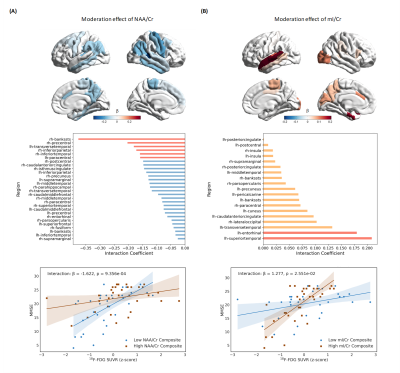 |
Screen Number: 1
0567. Neurometabolic
Signatures of Cognitive Resilience in Alzheimer's Disease: A
Hybrid 3D-MRSI/PET Study

W. Li, M. Zhang, Y. Zhao, Y. Li, W. Jin, Y. Zhang, J.
Hu, Z-P Liang, Y. Li
Shanghai Jiao Tong University, Shanghai, China
Impact: Higher NAA/Cr and lower mI/Cr levels in the
parietal and temporal lobes may serve as promising markers
of CR in AD. These neurometabolic signatures may provide
insights into intervention strategies aimed at slowing
cognitive decline in AD.
|
| 13:32 |
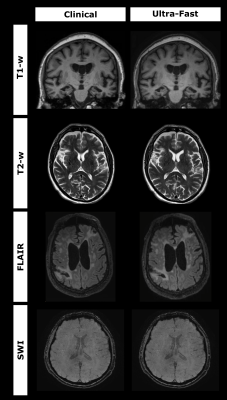 |
Screen Number: 2
0568. Clinical
validation of a multi-modal ultra-fast MRI protocol for dementia
diagnosis
H. Chughtai, D. Thomas, M. Rosa-Grilo, C. Sudre, B. Solanky,
E. Lim, D. Mallon, H. R. Jäger, L. Prosser, I. Malone, D.
Alexander, F. Barkhof, N. Fox, C. Mummery, G. Parker
University College London, London, United Kingdom
Impact:
By significantly decreasing scan time, our validated ultra-fast protocol enables wider access to MRI for patients with dementia, whilst maintaining diagnostic utility, reducing healthcare costs and improving the patient experience. |
| 13:34 |
 |
Screen Number: 3
0569. Mapping
the Progressive Degeneration of the Olfactory Cortex from Normal
Cognition to Alzheimer's Disease
C. GUO, S. YANG, Y. CAO, B. XIE, Z. SHEN, N. ZHENG, Y. YANG,
H. ZHANG
The First Hospital of Jilin University, Changchun, China
Impact: These
findings advance our understanding of hemispheric
vulnerability in early neurodegeneration, offering potential
insights for therapeutic intervention before widespread
impairment occurs. The identified progression pattern may
contribute to developing more sensitive early detection
strategies in AD.
|
| 13:36 |
 |
Screen Number: 4
0570. Impaired
mitochondrial energy metabolism related to astrocyte in the
brain of Alzheimer’s disease
M. Ono, K. Hirata, R. Kono, K. Saito, Y. Maeda, Y. Abe, M.
Kawami, H. Shimizu, Y. Uchida, Y. Takado
National Institutes for Quantum Science and Technology, Chiba, Japan
Impact: This
study provides insights into impaired mitochondrial energy
metabolism associated with AD. Hyperpolarized [1-13C]pyruvate
MRS detected hippocampal metabolic changes in AD mouse model
at early pathological stages, and is expected to be applied
to pathological studies of AD.
|
| 13:38 |
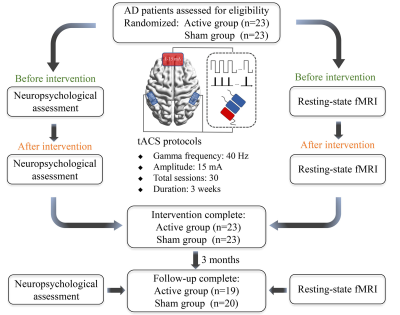 |
Screen Number: 5
0571. Altered
Functional Connectivity of Cortical Networks and Hippocampus by
Transcranial Alternating Current Stimulation in Alzheimer's
Disease
T. Wang, S. Yan, H. Xue, J. Lu
Xuanwu Hospital, Capital Medical University, Beijing, China
Impact: fMRI has furnished a precise neuroimaging
substrate for the efficacy assessment after tACS, helpful
for neurologists to capture neuronal activity modifications.
fMRI can elucidate the therapeutic variances and facilitate
the refinement of individualized and targeted stimulation
protocols for AD patients.
|
| 13:40 |
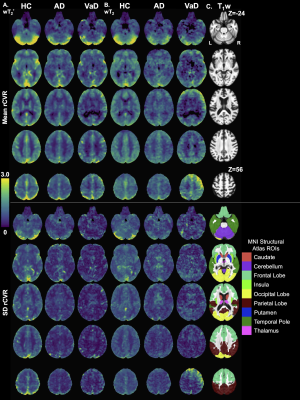 |
Screen Number: 6
0572. Characterization
of cerebrovascular reactivity in aging, Alzheimer’s disease, and
vascular dementia using multi-echo, multi-contrast MRI
E. Keeling, M. Bergamino, L. Ott, M. McElvogue, A. Burke, M.
Sabbagh, N. Bakkar, A. Stokes
Barrow Neurological Institute, Phoenix, United States
Impact: Complementary
assessments of CVR on total and microvascular scales may
comprehensively inform on differences in vascular integrity
between populations. The microvascular-weighted analysis was
sensitive to changes in CVR between groups and may be
specific to dementia-related pathology in the
microvasculature.
|
| 13:42 |
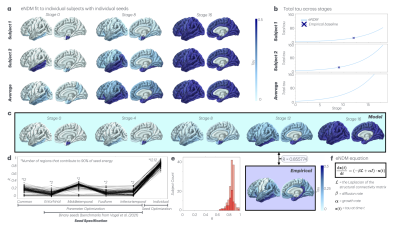 |
Screen Number: 7
0573. Integrating
Event-Based and Biophysical Models to Predict Individual Tau
Progression in Alzheimer's Disease
R. Sandell, J. Torok, D. Ma, A. Raj
UCSF, San Francisco, United States
Impact: Our method can be applied to explore
inter-subject heterogeneity of protein spread patterns
across a range of neurodegenerative conditions, enabling the
development of precision therapeutic treatments that target
individuals’ unique pathology.
|
| 13:44 |
Screen Number: 8
0574. Perfusion
Velocity in Temporal Lobe Decreases Prior to Its Change in Other
Brain Regions in Alzheimer’s Disease
Y. Guo, T. Liu, Y. Li, G. C. Chiang, W. Huang, M. J. d.
Leon, Y. Wang, F. Chen, L. Zhou
Department of Radiology, Hainan General Hospital (Hainan Affiliated Hospital of Hainan Medical University), Haikou, China
Impact: These findings suggest that the perfusion
velocity in temporal lobe supplied by MCA has the earliest
change among the whole brain regions, which may be an early
biomarker for AD diagnosis and offer a therapeutical target.
|
|
| 13:46 |
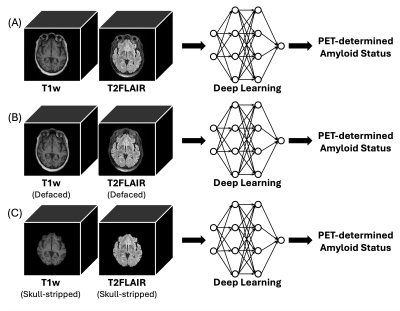 |
Screen Number: 9
0575. Impact
of Defacement on Deep Learning-based Amyloid Prediction with
Multi-contrast MRI
D. Kim, J. A. Ottessen, A. Kumar, B. Ho, C. Young, E.
Mormino, G. Zaharchuk
Stanford University, Stanford, United States
Impact: Defacing MRI scans for privacy inadvertently
removes information that may aid amyloid PET positivity
prediction, as shown by decreased model performance on
defaced images compared to non-defaced ones.
|
| 13:48 |
 |
Screen Number: 10
0576. Functional
Relationship with MR Elastography Measures of Basal Ganglia
Stiffness in Mild Cognitive Impairment
M. Kramer, A. Diano, K. Twohy, O. Bailey, L. Hiscox, M.
Cohen, A. Lanzi, C. Martens, C. Johnson
University of Delaware, Newark, United States
Impact: Basal ganglia stiffness correlates with function
in people with MCI. MCI subjects with higher stiffness than
controls experience improved mechanical and functional
measures following exercise intervention. The MCI diagnosis
may have specific subtypes that have different potential for
intervention success.
|
| 13:50 |
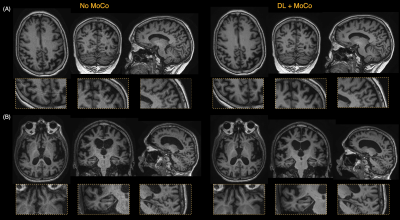 |
Screen Number: 11
0577. Clinical
Validation of Motion-Informed 3D Deep Learning Reconstruction in
Patients with Cognitive Impairment at 3T
S. Fujita, D. Polak, D. Nickel, D. Splitthoff, Y. Huang, N.
Gil, S. Buathong, C-H Chiang, W-C Lo, B. Clifford, S.
Cauley, J. Conklin, S. Huang
Athinoula A. Martinos Center for Biomedical Imaging Center, Boston, United States
Impact: Deep learning-based reconstruction with
integrated retrospective motion correction produced
high-quality 3D MPRAGE in patients with cognitive decline.
With clinically feasible processing times and robust
performance, this technique shows promise for a wide range
of neuroimaging protocols.
|
| 13:52 |
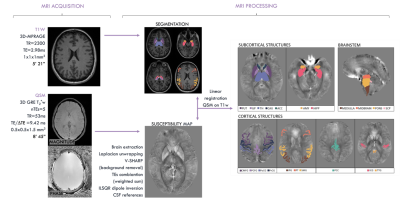 |
Screen Number: 12
0578. Pathological
Insights into Dementia with Lewy Bodies: The Role of
Quantitative Susceptibility Mapping
G. Venturi, E. Capogna, L. Motta, L. Guidi, D. Braghittoni,
L. Sambati, M. Mitolo, E. Cantoni, G. Sighinolfi, R. Lodi,
C. Tonon
IRCCS Institute of Neurological Sciences of Bologna, Bologna, Italy
Impact: This study demonstrates the potential of
quantitative QSM as a biomarker for DLB monitoring disease
progression. By linking brain iron deposition to cognitive
deficits, it paves the way for further research into the
underlying mechanisms of DLB.
|
| 13:54 |
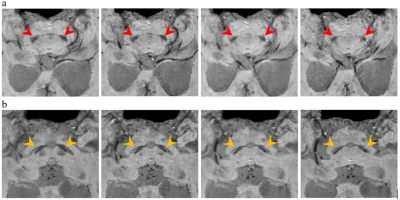 |
Screen Number: 13
0579. Enhancing
Diagnostic Accuracy in Parkinson’s Disease: The Impact of Deep
Learning- Based AI on Nigrosome 1 Imaging in Brain MRI
J. Park, B. Sohn
Samsung Medical Center , Seoul , Korea, Republic of
Impact: Deep learning-based AI improves the diagnostic
accuracy of nigrosome 1 abnormalities on Susceptibility
map-weighted imaging (SMwI) for Parkinson’s disease across
all radiological experience levels, which may extend its
role in clinical decision-making for PD diagnosis.
|
| 13:56 |
 |
Screen Number: 14
0580. Exploring
Neuromelanin's Significance: Comparative Insights from Advanced
MRI Techniques for Diagnosing Early-Stage Parkinson's Disease
C. Y. Lim, Y. H. Roh, B. Sohn
Samsung medical center, Seoul, Korea, Republic of
Impact: Our study highlights NM imaging in the SN as a
superior biomarker for early Parkinson’s disease diagnosis
compared to other imaging methods, offering clinicians a
more reliable diagnostic tool.
|
| 13:58 |
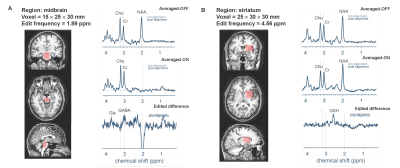 |
Screen Number: 15
0581. Assessing
Neurometabolic Alterations, Glutathione Depletion and Iron
Deposition in the Mesostriatal Pathway of Parkinson's Disease
S. Yan, B. Duan, X. Zhang, N. Zheng, W. Zhu
Tongji Hospital, Tongji Medical College, Huazhong University of Science and Technology, Wuhan, China
Impact: These findings offer valuable insights into the
pathophysiology of PD and may inform future therapeutic
strategies targeting metabolic and oxidative stress
pathways.
|
| 14:00 |
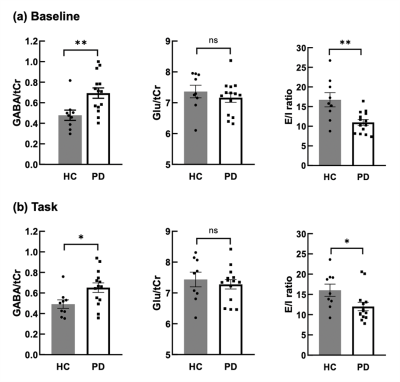 |
Screen Number: 16
0582. Disrupted
Excitatory-Inhibitory Balance in the Motor Cortex of Parkinson’s
Disease: A 7T MRS Study at Rest and Motor Tasks
N. Wei, D. Su, Z. Zhang, Y. Park, D. Deelchand, G. Genovese,
M. Marjanska, T. Feng, J. Jing, Z. Zhang
Beijing Tiantan Hospital, Capital Medical University, Beijing, China
Impact: This study highlights disrupted
inhibitory-excitatory balance in PD, providing insights for
targeted therapies to improve motor function. It also
prompts further investigation into neurotransmitter
regulation, potentially benefiting clinicians and
researchers in PD treatment development.
|
| 14:02 |
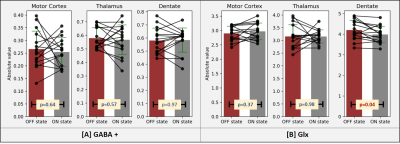 |
Screen Number: 17
0583. Post-levodopa
reduction of cerebellar Glx in Parkinson’s disease: Effect on
tremor severity
S. Prasad, D. Deelchand, M. Kumar, R. Yadav, P. Pal, J.
Saini
National Institute of Mental Health and Neuro Sciences (NIMHANS), Bengaluru, India
Impact: Cerebellar Glx drives tremor severity in PD, and
dopaminergic medication mediated reduction leads to an
improvement in tremor severity. These results provide the
first evidence of cerebellar Glx involvement in PD, and open
avenues for new therapeutic interventions.
|
| 14:04 |
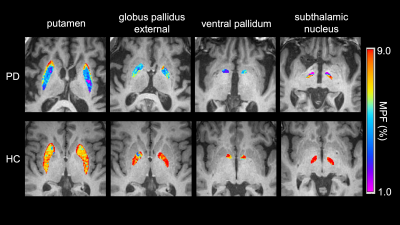 |
Screen Number: 18
0584. Macromolecular
Proton Fraction Mapping of Subcortical Nuclei in Patients with
Parkinson's Disease
Y. Fujiwara, N. Sakae, Y. Hirakawa, H. Kumazoe, K. Miyamoto,
H. Kan, M. Kitajima
Kumamoto University, Kumamoto, Japan
Impact: Decreased MPF may reflect neurodegeneration,
while increased magnetic susceptibility suggests iron
accumulation. Combining MPF and QSM measurements in
subcortical nuclei could aid in diagnosing Parkinson's
disease.
|
| 14:06 |
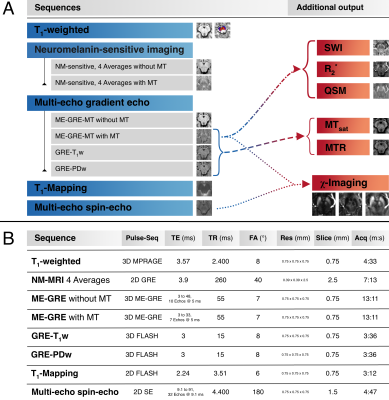 |
Screen Number: 19
0585. A
Novel Approach in Parkinson’s Disease Assessment using
Quantitative MRI for Neuromelanin, QSM and χ-Separation
M. Dittrich, A. Moussavi, R. Dadarwal, C. Riedel, S.
Boretius
DPZ, Göttingen, Germany
Impact:
Multiple studies have explored novel imaging approaches for Parkinson’s disease. Our MR protocol provides an effective, comprehensive multi-parametric approach to quantify neuromelanin loss, increased susceptibility, and changes in magnetization transfer, offering more precise quantitative biomarkers. |
| 14:08 |
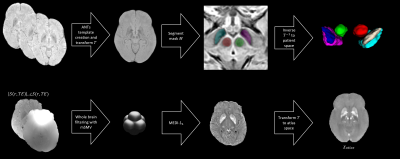 |
Screen Number: 20
0586. Whole
Brain Rapid Eye Movement Sleep Behavior Disorder Susceptibility
Atlas and Enabled Longitudinal Analysis
A. Roberts, C. Skudin, J. Li, T. Crewes, R. Gregory, P.
Spincemaille, A. Dimov, T. Nguyen, A. Shtilbans, Y. Wang
Cornell University, New York, United States
Impact: A whole brain multi-contrast rapid eye movement
sleep behavior disorder atlas is presented to facilitate
automatic segmentation. Such segmentations are helpful for
cross-sectional comparisons and longitudinal analysis in
healthy volunteer, REM sleep behavior disorder and
early-stage Parkinson’s disease populations.
|
| 14:10 |
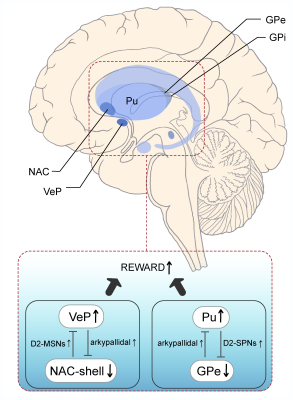 |
Screen Number: 21
0587. Decreased
iron deposition in ventral pallidum associated with analgesic
dependence and relapse in medication-overuse headache
X. Xu, J. He, M. Zhou, X. Wu, K. Yang, M. Zhang, K. Liu
Zhejiang University School of Medicine Second Affiliated Hospital, Hangzhou, China
Impact: Our findings show excessive iron accumulation in
subcortical areas correlates with increased migraine burden.
VeP iron levels are linked to analgesic dependence and MOH
relapse, emphasizing disrupted iron homeostasis in migraine
pathology and its implications for treatment strategies.
|
| 14:12 |
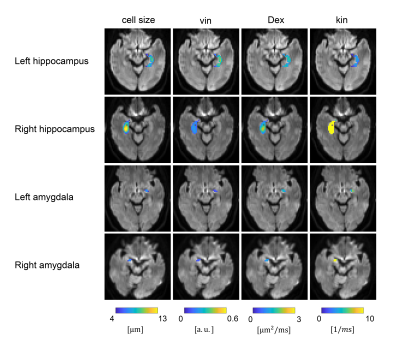 |
Screen Number: 22
0588. Time-Dependent
Diffusion MRI Reveals Smaller Cell Size with Stable Volume in
Hippocampus and Amygdala during Chemotherapy
X. Zhou, D. Shi, Y. Huang, T. Yin, D. Wu, H. Guo, J. Xu, D.
Liu, J. Zhang
Department of Radiology, Chongqing University Cancer Hospital, School of Medicine, Chongqing University, Chongqing, China
Impact: By combining Time-Dependent Diffusion MRI and 3D
T1WI MRI, a decrease in cell sizes with unchanged volume of
hippocampus and amygdala among breast cancer patients was
identified with repeated measurements during neoadjuvant
chemotherapy, aiding early diagnosis and treatment of
chemo-brain.
|
| 14:14 |
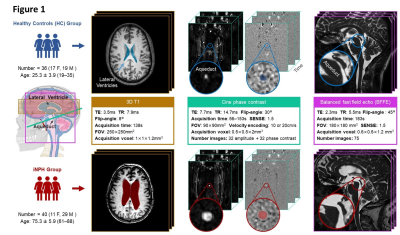 |
Screen Number: 23
0589. Aqueduct
pressure gradient quantified by MRI in hydrocephalus
populations.
O. BALEDENT, P. LIU, Y. ATTEKEBLE, J. XIE, H. MONNIER, S.
METANBOU, K. OWASHI, C. CAPEL
University Hospital CHU Amiens, Amiens, France
Impact: Studying aging healthy individuals,
hydrocephalus patients without improvement after shunt,
Alzheimer’s populations may reveal new biomarkers to improve
diagnosis and patient selection for shunt surgery. Such
investigations will deepen our knowledge of the
physiopathology of ventricle dilation and CSF clearance.
|
| 14:16 |
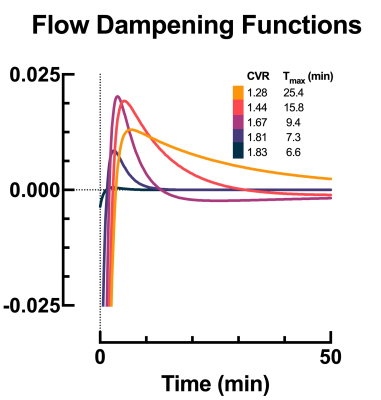 |
Screen Number: 24
0590. Arterial
spin labelling-based evaluation of cerebrovascular reserve
impairment using a mathematical convolution model
M. Fahlström, J. Sousa, T. Svedung Wettervik, J. Berglund,
P. Enblad, A. Lewén, J. Wikström
Uppsala University, Uppsala, Sweden
Impact: Flow dampening functions in conjunction with
modelling of the cerebrovascular response after
acetazolamide injection may be used as a clinical surrogate
in patients with moyamoya disease. Further studies are
warranted analysing longitudinal datasets and normal
material.
|
The International Society for Magnetic Resonance in Medicine is accredited by the Accreditation Council for Continuing Medical Education to provide continuing medical education for physicians.